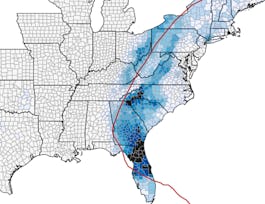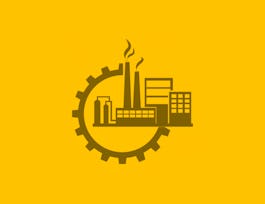This course is designed to take your Unreal Engine 5 skills to the next level with advanced visual effects, simulations, and cinematic finishing techniques. You’ll begin by mastering the Niagara particle system, where you’ll create custom particle materials and complex water effects. These skills will extend to creating splash effects, dynamic ripples, and integrating them into your environments for enhanced realism.

Give your career the gift of Coursera Plus with $160 off, billed annually. Save today.


Mastering VFX, Simulation & Finalizing Projects in UE5
This course is part of UE5: Beginner’s Guide to Building a 3D Environment Specialization

Instructor: Packt - Course Instructors
Included with 
Recommended experience
What you'll learn
Design and customize Niagara particle systems for water and fire VFX
Simulate fluid dynamics and atmospheric effects to create realistic environments
Finalize projects by applying color grading, configuring camera setups, and producing high-quality renders
Skills you'll gain
Details to know

Add to your LinkedIn profile
October 2024
6 assignments
See how employees at top companies are mastering in-demand skills

Build your subject-matter expertise
- Learn new concepts from industry experts
- Gain a foundational understanding of a subject or tool
- Develop job-relevant skills with hands-on projects
- Earn a shareable career certificate


Earn a career certificate
Add this credential to your LinkedIn profile, resume, or CV
Share it on social media and in your performance review

There are 14 modules in this course
In this module, we will explore Unreal Engine 5’s Niagara particle system to create water-based visual effects. You’ll learn to design custom particle textures, simulate water splashes, and add dynamic motion to particles for a realistic water system.
What's included
5 videos2 readings
In this module, we will focus on creating additional water motion effects such as ripples and flow. You’ll learn to generate these effects using materials and combine them with Niagara particles for a complete water system.
What's included
3 videos
In this module, we will take the water VFX created in earlier lessons and apply them to both flowing and still water environments. You’ll learn how to seamlessly integrate these effects into your Unreal Engine 5 projects.
What's included
2 videos1 assignment
In this module, we will create detailed terrain for background environments using heightmap textures. You’ll also learn how to apply automatic materials to ensure the landscape adapts to its geometry.
What's included
2 videos
In this module, we will explore lighting and atmospheric effects to create a realistic sky for your environment. You’ll learn how to adjust sunlight, sky color, and add volumetric clouds and fog for a dynamic atmosphere.
What's included
4 videos
In this module, we will explore Unreal Engine 5’s fluid simulation system to create fire VFX. You’ll learn to adjust parameters for a more realistic fire simulation, controlling density and smoke effects within your scene.
What's included
3 videos1 assignment
In this module, we will enhance the fire VFX by adding ember particles and creating a flickering light blueprint. You’ll learn how to control lighting effects that synchronize with fire intensity, adding more depth to your fire simulations.
What's included
2 videos
In this module, we will explore UE5’s sculpting functionality to create organic shapes. You’ll sculpt a bird mesh that can be used within your 3D environment.
What's included
1 video
In this module, we will add motion to our bird models using vertex animations. You’ll learn to animate a flock of birds flying across the sky using Unreal Engine 5’s sequencer for realistic movement.
What's included
3 videos1 assignment
In this module, we will create firefly particles and animate their movement using the Niagara system. You’ll learn how to simulate firefly behavior with specific motion patterns, enriching your 3D scene with dynamic lighting effects.
What's included
2 videos
In this module, we will focus on refining water visuals by tweaking color and reflection values. You’ll ensure your water integrates seamlessly with the lighting conditions of your scene.
What's included
1 video
In this module, we will explore Unreal Engine 5’s post-processing tools to color grade your environment. You’ll learn how to apply vibrant color effects to elevate the mood and tone of your scene.
What's included
1 video1 assignment
In this module, we will focus on setting up a cinematic camera to frame your 3D environment. You’ll learn the fundamentals of camera placement and composition for professional-quality renders.
What's included
1 video
In this module, we will cover how to render your completed environment, creating a professional-quality video of your work. Additionally, you’ll learn bonus techniques for setting up curved river meshes to enhance water features.
What's included
2 videos1 reading2 assignments
Instructor

Offered by
Recommended if you're interested in Software Development

Johns Hopkins University

University of Leeds
Why people choose Coursera for their career




New to Software Development? Start here.

Open new doors with Coursera Plus
Unlimited access to 7,000+ world-class courses, hands-on projects, and job-ready certificate programs - all included in your subscription
Advance your career with an online degree
Earn a degree from world-class universities - 100% online
Join over 3,400 global companies that choose Coursera for Business
Upskill your employees to excel in the digital economy
Frequently asked questions
Yes, you can preview the first video and view the syllabus before you enroll. You must purchase the course to access content not included in the preview.
If you decide to enroll in the course before the session start date, you will have access to all of the lecture videos and readings for the course. You’ll be able to submit assignments once the session starts.
Once you enroll and your session begins, you will have access to all videos and other resources, including reading items and the course discussion forum. You’ll be able to view and submit practice assessments, and complete required graded assignments to earn a grade and a Course Certificate.



